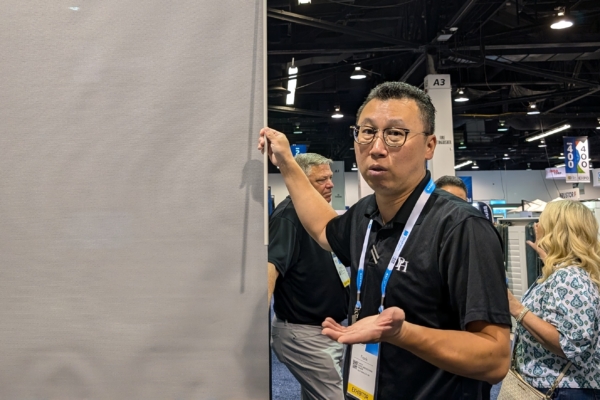In accordance with the Statista database forecast, the revenue of the global curtain and blinds market is expected to reach $42.14 billion in 2024, with an annual growth rate of 4.95%. Traditionally, Taiwan’s curtain industry not only ranks among the top three “customized” blind brands in the United States, but has also been actively expanding into markets in Europe, Australia, and Japan in recent years, maintaining a leading global position.
Originating from a family business in window coverings in Lukang, Changhua, Frank Hsu, whose predecessors started with manufacturing bamboo blinds, established his company in California in 2002. Initially, his focus was on distributing cordless roller blind components in the U.S., including ready-made cut blinds, cordless honeycomb blinds, and cordless faux wood blinds.
Hsu explained that cordless blinds are designed to hide the cords to prevent accidents, especially during children’s playtime. In Canada, legislation already requires the complete use of cordless blinds, prohibiting any exposed cords. As of June this year, all blind products manufactured and sold in the U.S. have also eliminated free-hanging operation cords, and revised safety standards will drive the demand for cordless blinds in the American market.
The Taiwanese curtain industry made its early debut in the international market. According to Hsu’s estimate, Taiwan brands hold over 80% market share in global hard window coverings, such as blinds, Roman shades, and wooden blinds – contrasting with soft fabric window coverings. This dominance is attributed to the agility of Taiwanese businesses in responding to market trends, producing products compliant with safety standards, obtaining multiple international certifications, offering lower labor costs than in Europe and the U.S., as well as excelling in design and quality compared to other countries.
Benefitting from increased stocking by physical retail clients like Home Depot, Lowe’s, Walmart, IKEA, and diverse online sales channels, Hsu has been extremely busy this year. He noted, “After the epidemic, the development direction of the entire industry has become unpredictable.” While the curtain industry typically experiences peak and off-peak seasons, many individuals engaged in home office setups during the pandemic, leading to increased home renovations. Consequently, Hsu and his peers have been busier than usual recently, although fluctuations in curtain sales volume have occurred after this wave of home remodeling trends.
Hsu and his company team participated in the Sun Shading Expo held at the Anaheim Convention Center in Orange County, California from the 24th to the 26th of last month. The expo featured nearly a hundred exhibitors from around the world showcasing and introducing the latest products in external and internal sun shading systems, sun awnings, blinds and accessories, technical textiles for internal and external sun shading systems, drives, and more.
Cordless blinds and eco-friendly materials are two major trends driving the development of hard window coverings globally. Hsu pointed out that each product has its advantages and disadvantages. For instance, cellular shades, with their unique hexagonal structure, offer efficient heat insulation and energy-saving capabilities, particularly suitable for windows exposed to direct sunlight to reduce air conditioning usage, save energy, and align with environmental trends. However, due to material characteristics, they are difficult to remove wrinkles from and are not waterproof, making them prone to mold in humid environments.
The market demand for motorized blinds is rapidly increasing as smart homes become more prevalent. Many companies have developed dedicated apps that enable consumers to control blinds through their smartphones, remote controls, or voice commands, enhancing the convenience and intelligence of products. Hsu mentioned that while electric blinds are mostly used in large residences and commercial spaces and come at a higher price, advancements in technology and cost reductions are expected to expand the market continuously.
Hsu stated that Americans typically change their home curtains every three to five years, depending on factors like curtain material, duration of sunlight exposure, and interior style changes. For instance, with the approach of Christmas, some families wish to renovate indoor decorations, including their curtains.
Consumer demand for curtains not only focuses on light blocking and heat insulation but also emphasizes convenience and aesthetics, giving rise to increased customization needs. Hsu revealed that although his company offers a wide range of curtain colors, most customers still prefer “white.”
Despite Taiwan’s technical and market advantages, Hsu acknowledged the competitive pressure brought by low-cost Chinese manufacturers to global players. Chinese curtain makers swiftly capture market share through pricing strategies, often leading consumers to temporarily overlook quality and service due to price considerations.
Facing pricing competition, Hsu remains optimistic, believing that maintaining high-quality products and superior services will allow companies to break through price competition. He emphasized that although people may temporarily disregard quality and service, after comparing products from various sources, they will ultimately pay for what best suits their needs. Customization, after-sales service, and product durability are strengths of Taiwanese curtains.
With rising labor costs in China and increased supply chain uncertainties, many Taiwanese companies view Vietnam as a more cost-competitive production base. Hsu’s company has relocated most of its manufacturing plants from mainland China to Vietnam and is gradually investing in automation to enhance production efficiency and reduce reliance on labor.
While e-commerce platforms are changing some industry norms, Hsu believes that offline services are still essential for precise installation and custom-made curtains. Even minor size discrepancies can affect the installation effect of curtains. Therefore, while the company maintains strong online sales, it also retains a robust offline installation and service team to ensure providing the best installation experience for each customer. Long-term cooperation and establishing solid relationships with customers are key to Hsu’s successful business operation.

